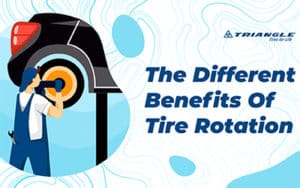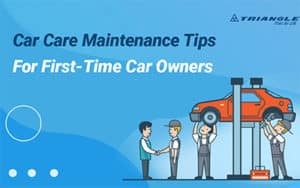There’s a common saying that if you take care of things, they last. For example, when you get regular health checkups, it’s easier to stay in tip-top shape.
Likewise, car care maintenance keeps your vehicle in optimal health and helps spot any issues that need fixing. But regular upkeep while doing unhealthy practices can still lead to problems.
Regularly maintaining your vehicle is useless if you have bad driving habits. Likewise, your effort to care for your car can be meaningless if you’re constantly causing damage to it.
9 Driving Habits That Are Damaging Your Tires (and How to Fix Them)
You may not realize it, but you could be making some of these bad driving habits. It’s important to know if your practices are destructive to your vehicle and how to prevent more damage, especially to the tires.
1. Overloading your vehicle
Cars usually get the most stress during long trips and when loaded at full capacity. These situations typically happen during family outings and moving to a different location. Although your car can carry a heavy load, it still has limits. Going beyond it puts an unnecessary strain on your tires, brakes, drivetrain, and suspension.
Check your car owner’s manual to get a general idea of how much luggage your car can take. Then, travel as lightly as possible, emptying your car of items not needed during daily trips.
2. Hitting potholes or bumps at full speed
Did you know that potholes account for a third of all car damage? Running fast around them can cause numerous car troubles, including a damaged or flat tire, impaired wheels, and beat-up suspension. Bad driving habits like this can also lead to lumps in the tire, cracked alloys, and wheel misalignment. Inspect, repair, or replace your tires in these cases.
The best thing to do is avoid potholes and bumps on the road, but sometimes it’s impossible. Hence, the solution is to slow down as you approach them. Doing this will minimize or prevent car or tire damage.
3. Skipping regular wheel rotation and alignment
With many kilometers and road bumps ahead, your vehicle’s tires will eventually wear out. Unfortunately, skipping wheel rotation and alignment shortens tire life. By contrast, tire rotation provides some relief to this issue. It lets tires wear out evenly, preventing one-sided damage and maximizing capacity.
Tire rotation benefits front tires since they suffer more stress due to steering and directional control. Regular tire rotation and alignment can improve tire tread life, vehicle performance, and fuel economy.
4. Dry steering
Another terrible practice among drivers is dry steering or turning the wheel while the vehicle is not moving—like when you’re waiting in a drive-thru or stuck in traffic. Again, it may seem harmless, but dry steering wears out tires, causing uneven abrasions or bald spots.
With the car standing still, pressure builds up on the tires as they rub against the ground. Steer away from this damaging habit and only turn the wheel when rolling.
5. Sudden braking
Emergency stops are part of driving. For example, the stoplight may turn red at the very last second or a vehicle may unexpectedly cut in front of you. Such instances require sudden braking, but jamming on the brakes too often damages tire treads, pads, and discs.
A good practice is to avoid distractions and give your full attention while driving. It will save you from car trouble and prevent accidents, keeping you, other motorists, and pedestrians safer.
6. Not routinely checking PSI
Tire pressure affects tire functionality; hence, being under or overinflated can cause improper road contact. Over time, this can lead to premature tire damage.
Therefore, it’s crucial to check your tire pressure about 2–3 times a month and maintain the correct tire pressure. Tire pressure requirements vary by vehicle; however, most are between 30 and 35 PSI (pounds per square inch).
If you are unsure about your car’s tire pressure, you can check your car’s handbook or find the sticker inside the driver’s door post. You may also get assistance from your local tire service center.
7. Driving in terrain not suitable for current car tires
An adventurous trip with your friends sometimes calls for an off-road driving experience where you must power through rocky or muddy roads. Although some vehicles are suitable for such conditions, the experience can still take a toll on your tires. If you can’t avoid unpaved roads, drive cautiously and avoid obstacles that may damage your tires. Better yet, switch to quality tires meant for the terrain.
8. Turning at a fast speed or too quickly
Last-second turns are another of the many bad driving habits that can kill your tires. You probably experienced almost missing a turn and had to steer quickly. But this practice wears out tire treads and even leaves rubber on the road. To avoid this, be attentive while driving to make turns properly. It will prolong your tire life and save you money.
9. Driving at top speed
Some drivers like to test how powerful their cars can go, driving at top speed on expressways or empty roads. Unfortunately, this strains the engine and damages different parts of your vehicle, especially the tires.
During high-speed driving, there’s more friction between the tires and the road, causing the tires to generate more heat. The longer the heat exposure, the softer the tire gets and the faster it wears out.
The next time you’re in the mood for an adrenaline rush on the road, remember the damage it does to your car and the possibility of road accidents. Choose safety if there’s no valid reason to drive at full speed.
Break Bad Driving Habits and Save Your Tires
Braving the road in your car entails many demands. Sometimes, drivers forget best practices and form damaging habits. But as a driver, you must be aware of these and correct them to ensure safety and maximize vehicle and tire life.
If you’re looking for quality tires, Triangle Tires can help. We have a wide array of tires—from passenger cars and light trucks to heavy equipment vehicles—available for delivery at an affordable price.
Browse our tire catalog, or contact us for your tire needs.


